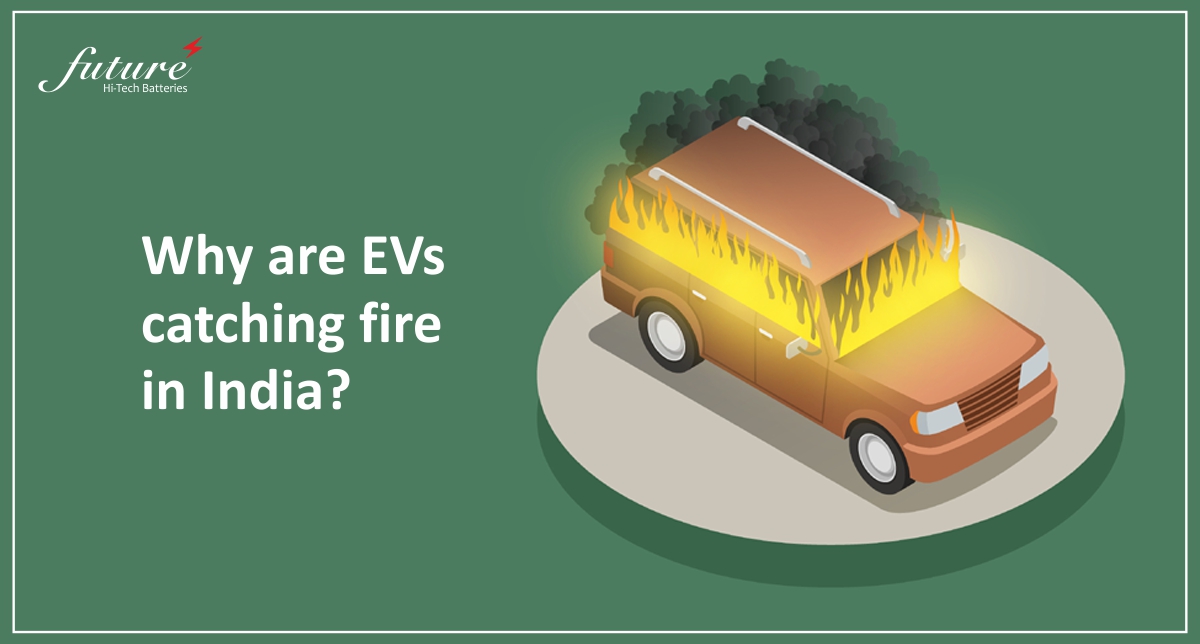The article is an overview of the alarming and undeniable number of EVs catching fire across India and the plausible reasons

Lorem ipsum dolor sit amet, nec in adipiscing purus luctus, urna pellentesque fringilla vel, non sed arcu integer, mauris ullamcorper ante ut non torquent.
Electrical vehicles have been accepted as the ideal alternative to transportation in India. Their cost-efficiency and the minimal maintenance required makes them desirable in the long run. These are just a few of the many aspects that make them acceptable and desired within the country.
However, recent incidences of alarming fires in EVs have led to serious concerns related to standards and protocols within the country. Are these fires accidental or is there a far more serious underlining cause?
To sight a few cases, a report from December 2021 in the Economic Times covered an electric scooter that caught fire in Mumbai. It was also reported that this was the fourth fire incident in the industry since September this year. In another case, a video went viral on the internet where an electric scooter was burning in flames. The company responded by holding a third-party vendor responsible for this misfortune. In yet another incident, there were two fire mishaps causing a fatality – once again causing a row on the safety and security of EVs. In yet another instance – a report carried out in the Hindustan Times in May 2022 reported an EV explosion in Telangana. The cases have left the masses and industry professionals concerned about the cause of the explosions, leaving room for speculation. However, let’s analyze the subject from an objective perspective and look at the possible reasons for the fires…
The import of batteries and assembling in India – Quality checks and balances
Electric Vehicle companies import their batteries and assemble the parts in India. Also, these parts are imported in SMD format. Prior to assembling, checks and balances are not necessarily in place. There is also a lack of knowledge to cross-check and examine the quality of the product.
India’s extreme climatic conditions
Currently, batteries for EVs are largely imported and are constructed to cater to foreign climatic conditions. Whereas, India has a hot and humid climate for most of the year. The batteries cannot endure such high temperatures and eventually this could lead to overheating and a blast. Gagan Kaur, Executive Director, Future Hi-Tech Batteries, says: “A cell having the capacity to endure 30-degree to 35-degree Celsius of temperature starts malfunctioning once it reaches above 55 degrees because battery coolants are missing.” The very construct of the batter has a crucial role in how it operates.
The load on the battery
We must remember that most of the parts for EVs are imported from other countries. Similarly, their batteries are designed is to meet the need of the people riding on their vehicles. In India, we don’t have stringent norms in place restricting the number of riders. Very often we see two-wheelers carrying two or even more than two riders. This can increase the load on the EV battery and can result in an explosion. Gagan Kaur describes the pillion riding situation, she says: “Manufacturers assume that the vehicle will be only carrying a single rider, but practically there are pillion riders, especially in India. The battery cannot load more than one rider.”
Malfunctioning Cells
A compromised state of a battery’s efficiency can affect performance and subsequently lead to a malfunction. Some of the factors responsible for malfunctioning cells are poor quality, improper management, lack of synchronization, and missing thermal management.
Explaining the vulnerable state of EVs assembling process in India, Gagan Kaur highlights: “Manufacturers also may assemble the products cheaply, give a KM range, and then supply to customers. The problem is that these products are not well inspected, they do not match the application criteria, and are not selected well. So, they compromise with the cells, and it starts malfunctioning.” Reiterating that malfunctioning cells and their performance can be due to the quality of cells, improper management, lack of synchronization, and missing thermal management.
Cheap Ensemble
Competition is an issue and very often we see a competitive landscape for the cheapest and most compact cost range. The fight to deliver efficiency at a lower cost has its pros and cons – research and development are highly compromised and the end result is nothing short of catastrophic.
There are many who have sighted challenges with regard to the issue and have voiced their opinions. Niti Aayog member, V K Saraswat has expressed how imported batteries for EVs are not suitable for Indian conditions. The cells are required to be manufactured locally to understand India’s weather, trends, and roads. Union minister Nitin Gadkari states that there needs to be firm action taken against EV firms for neglecting safety measures.
It is worth noticing that the traders and assembling units import cells without proper knowledge of facilities, standards, and thermal management. To close, Gagan Kaur once again leaves us with a noteworthy thought. She says: “Cells in the EVs are not properly inspected, do not match the application criteria, and are not selected well. So, they compromise with the cells, and it starts malfunctioning.” Also, pointing to the lack of research she adds: “The small EV players in the market are either client-folded when it comes to product quality, research, and development or doesn’t intend to look after them.”










Your Comment Please